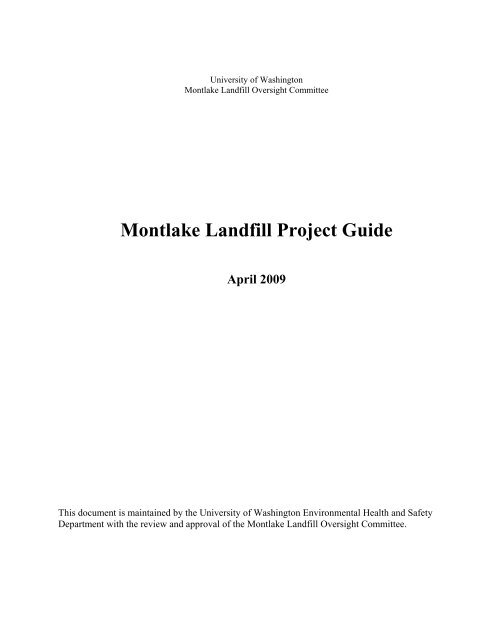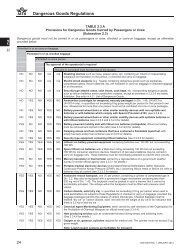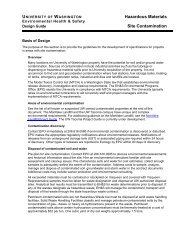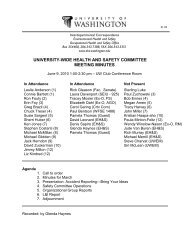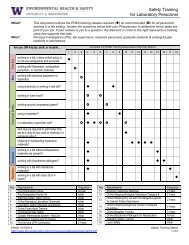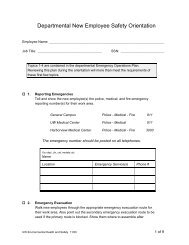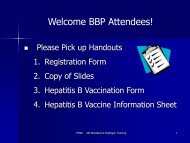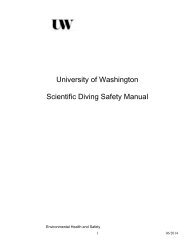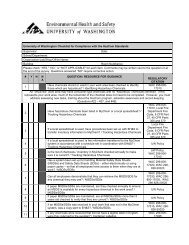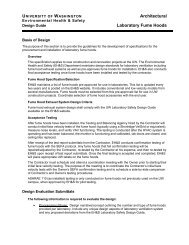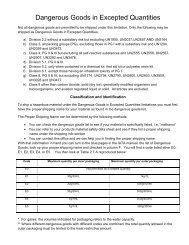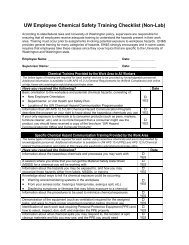Montlake Landfill Project Guide - Environmental Health and Safety ...
Montlake Landfill Project Guide - Environmental Health and Safety ...
Montlake Landfill Project Guide - Environmental Health and Safety ...
You also want an ePaper? Increase the reach of your titles
YUMPU automatically turns print PDFs into web optimized ePapers that Google loves.
University of Washington<strong>Montlake</strong> <strong>L<strong>and</strong>fill</strong> Oversight Committee<strong>Montlake</strong> <strong>L<strong>and</strong>fill</strong> <strong>Project</strong> <strong>Guide</strong>April 2009This document is maintained by the University of Washington <strong>Environmental</strong> <strong>Health</strong> <strong>and</strong> <strong>Safety</strong>Department with the review <strong>and</strong> approval of the <strong>Montlake</strong> <strong>L<strong>and</strong>fill</strong> Oversight Committee.
<strong>Montlake</strong> <strong>L<strong>and</strong>fill</strong> Guidance Document 4/16/2009Table of ContentsI. Introduction ............................................................................................................................ 3History ................................................................................................................................... 3Figure 1 – Approximate Boundaries of the <strong>Montlake</strong> <strong>L<strong>and</strong>fill</strong> ...................................................... 4Oversight ................................................................................................................................ 4Regulatory Requirements ......................................................................................................... 5II. <strong>Project</strong> Planning ...................................................................................................................... 5III. <strong>Environmental</strong> Requirements <strong>and</strong> MLOC <strong>Guide</strong>lines .................................................................. 5A. <strong>L<strong>and</strong>fill</strong> Settlement <strong>and</strong> Displacement ................................................................................ 6B. Grading ........................................................................................................................... 6C. Drainage ......................................................................................................................... 6D. Stockpiling ...................................................................................................................... 6E. Resurfacing Roads <strong>and</strong> Parking Areas ................................................................................ 7F. Methane Gas ................................................................................................................... 7G. Stormwater Control .......................................................................................................... 8H. Critical Areas, Wetl<strong>and</strong>s <strong>and</strong> Shorelines ............................................................................. 8J. Asbestos-Containing Material ......................................................................................... 10K. Worker <strong>Safety</strong> ............................................................................................................... 10L. Fencing ......................................................................................................................... 10M. Sports Fields .................................................................................................................. 10N. Corrosion Protection ...................................................................................................... 10O. Structure Foundations ..................................................................................................... 11AppTable 1 – <strong>Montlake</strong> <strong>L<strong>and</strong>fill</strong> Water <strong>and</strong> Debris Analytical Requirements ...................................... 12Page 2 of 12
<strong>Montlake</strong> <strong>L<strong>and</strong>fill</strong> Guidance Document 4/16/2009I. IntroductionThe <strong>Montlake</strong> <strong>L<strong>and</strong>fill</strong>, part of the University’s East Campus, is a unique environment containing theUnion Bay Natural Area, shorelines, wetl<strong>and</strong>s <strong>and</strong> a riparian corridor. The area is currently used forvehicle parking, teaching <strong>and</strong> research, <strong>and</strong> bird watching. Sports facilities, a golf driving range, <strong>and</strong> ahelipad also occupy the site. Boundaries of the East Campus area are delineated in the UW SeattleCampus Master Plan, dated January 2003. No changes are anticipated to these boundariesThis document identifies key issues <strong>and</strong> regulations applicable to the <strong>Montlake</strong> <strong>L<strong>and</strong>fill</strong> <strong>and</strong> immediatevicinity. It presents guidelines for maintenance <strong>and</strong> construction activities on the l<strong>and</strong>fill area. It is basedon the 1993 East Campus Maintenance Plan <strong>and</strong> supplements the Management Plan for the Union BayShoreline <strong>and</strong> Natural Area owned by the University of Washington as amended, which can be obtainedfrom the Center for Urban Horticulture. In addition, it incorporates recommendations made by the<strong>Montlake</strong> <strong>L<strong>and</strong>fill</strong> Oversight Committee (MLOC) presented in the 1999 <strong>Montlake</strong> <strong>L<strong>and</strong>fill</strong> InformationSummary.HistoryThe old <strong>Montlake</strong> <strong>L<strong>and</strong>fill</strong>, sometimes known as the Ravenna <strong>L<strong>and</strong>fill</strong>, was operated as a burn dump <strong>and</strong>eventually a l<strong>and</strong>fill by the City of Seattle from about 1926 to 1966. Municipal solid waste, primarilyconsisting of residential wastes, was disposed in the l<strong>and</strong>fill. Some limited amounts of industrial wastethat could be considered hazardous were also disposed there.Figure 1 is a map of the <strong>Montlake</strong> <strong>L<strong>and</strong>fill</strong> area. The exact boundaries of the <strong>Montlake</strong> <strong>L<strong>and</strong>fill</strong> are notdefinitively known. However, available documentation suggests that the l<strong>and</strong>fill is bounded by <strong>Montlake</strong>Boulevard NE to the west; NE 45 th Street to the north; Laurel Village <strong>and</strong> the Douglas ResearchConservatory to the east; <strong>and</strong> Canal Road, the Intramural Activities Building, <strong>and</strong> Union Bay to thesouth.The l<strong>and</strong>fill was closed in 1971 following the l<strong>and</strong>fill st<strong>and</strong>ards in place at that time <strong>and</strong> was capped withapproximately two feet of clean soil. L<strong>and</strong>scaped areas were to receive an additional six inches oftopsoil. Based upon trenching, borings, <strong>and</strong> excavations on previous projects, the cap is less than twofeet thick in some locations <strong>and</strong> solid waste may be directly under the asphalt in other locations. Aprotective 3-foot clean soil cap is currently required by the University.The l<strong>and</strong>fill consists of varying depths of fill, refuse <strong>and</strong> peat <strong>and</strong> has therefore experienced drainageproblems due to differential settlement. Clean fill has been added <strong>and</strong> minor repair work done on theroads, parking areas <strong>and</strong> sports fields to maintain site usability.Methane gas is produced in varying concentrations both from the large underlying peat deposit <strong>and</strong> fromdecomposing l<strong>and</strong>fill debris.Page 3 of 12
<strong>Montlake</strong> <strong>L<strong>and</strong>fill</strong> Guidance Document 4/16/2009Figure 1 – Approximate Boundaries of the <strong>Montlake</strong> <strong>L<strong>and</strong>fill</strong>OversightIn 1999, UW Executive Vice President Weldon Ihrig established the <strong>Montlake</strong> <strong>L<strong>and</strong>fill</strong> OversightCommittee (MLOC) to help ensure that “l<strong>and</strong>fill issues are not forgotten <strong>and</strong> that appropriate use <strong>and</strong>protection of the site is ensured in perpetuity.” The MLOC meets each calendar quarter to assess current<strong>and</strong> proposed activities in <strong>and</strong> near the l<strong>and</strong>fill area <strong>and</strong> evaluate new information <strong>and</strong> regulationsassociated with the l<strong>and</strong>fill.In 2000, the departments of Public <strong>Health</strong> - Seattle & King County (Public <strong>Health</strong>) <strong>and</strong> Ecologyconducted a site hazard assessment of the <strong>Montlake</strong> <strong>L<strong>and</strong>fill</strong>. While their assessment did not allow thel<strong>and</strong>fill to be taken off the list of hazardous sites, results indicated that if the <strong>Montlake</strong> <strong>L<strong>and</strong>fill</strong> were leftundisturbed, the risk of adverse impacts to human health <strong>and</strong> the environment would be low, <strong>and</strong> they didnot require any remedial cleanup of the existing l<strong>and</strong>fill area. However, some maintenance, renovation,<strong>and</strong> construction activities could disturb the <strong>Montlake</strong> <strong>L<strong>and</strong>fill</strong>. Because of the compliance risks, EH&SPage 4 of 12
<strong>Montlake</strong> <strong>L<strong>and</strong>fill</strong> Guidance Document 4/16/2009must be contacted at 206.616.0585 prior to any activities having the potential to penetrate the l<strong>and</strong>fill cap.Regulatory RequirementsTitle 10 - King County Solid Waste Regulations, administered by Public <strong>Health</strong> - Seattle & King County,impact the UW’s use of the <strong>Montlake</strong> <strong>L<strong>and</strong>fill</strong> area. Among other requirements, UW must provideadequate venting of gases generated by solid waste, prevent migration of methane, <strong>and</strong> protect enclosedstructures from methane migration. The UW conducts quarterly methane gas monitoring <strong>and</strong> hasdeveloped a Methane Action Plan to implement methane mitigation measures whenever methanemonitoring results consistently exceed regulatory actions levels.The UW complies with other requirements by working closely with Public <strong>Health</strong>. The UW provideswork plans, site plans, <strong>and</strong> specifications for all structures <strong>and</strong> major site improvements proposed on thefootprint of the <strong>Montlake</strong> <strong>L<strong>and</strong>fill</strong>. Public <strong>Health</strong> reviews the submittals to determine if public healthrisks have been adequately addressed. After review, Public <strong>Health</strong> will provide comments,recommendations, <strong>and</strong>/or approval to the UW for the proposed structure or improvement project.II.<strong>Project</strong> PlanningConstruction <strong>and</strong> maintenance projects within the <strong>Montlake</strong> <strong>L<strong>and</strong>fill</strong> boundary usually have longertimelines <strong>and</strong> higher costs due to structure requirements <strong>and</strong> disposal costs. The UW <strong>Project</strong> Managermust plan ahead as much as possible to shorten timelines <strong>and</strong> minimize costs.<strong>Project</strong> Managers <strong>and</strong> EH&S staff must coordinate closely whenever construction or excavation occurson the l<strong>and</strong>fill. EH&S reviews activities having the potential to penetrate the l<strong>and</strong>fill cap <strong>and</strong> disturbl<strong>and</strong>fill debris. EH&S will determine <strong>and</strong> arrange for proper disposal of excavated materials based uponsampling performed by the environmental consultant. EH&S will also provide hazardous wastemanifests if contaminants are detected above regulatory limits.The following are general l<strong>and</strong>fill project planning recommendations based on experience with previousprojects:• Investigate all available records for information on the specific location <strong>and</strong> l<strong>and</strong>fill materialsplaced in that vicinity. Municipal solid waste (MSW) was disposed of in the l<strong>and</strong>fill <strong>and</strong> includeswaste that could be regulated dangerous waste. The area of the l<strong>and</strong>fill is generally known, but theboundaries are not entirely clear. The Facilities Records Office has aerial photographs of thel<strong>and</strong>fill that may help locate the extent <strong>and</strong> age of the l<strong>and</strong>fill material.• If a site is more contaminated than assumed, consider alternative designs or methods.• Keep maintenance activities that generate l<strong>and</strong>fill waste to a minimum. Certain maintenanceactivities such as fence pole installations <strong>and</strong> utility line repairs may be shallow enough to avoidl<strong>and</strong>fill debris. Nonetheless, soils removed must be evaluated prior to disposal or reuse on site.• EH&S provides regulatory <strong>and</strong> technical assistance, <strong>and</strong> in most cases, is the liaison to regulatoryagencies for the UW. However, the project manager may need to acquire the services ofconsultants to assist in environmental planning, design, <strong>and</strong> the collection of environmentalsamples.III. <strong>Environmental</strong> Requirements <strong>and</strong> MLOC <strong>Guide</strong>linesPage 5 of 12
<strong>Montlake</strong> <strong>L<strong>and</strong>fill</strong> Guidance Document 4/16/2009UW administrative policy (Administrative Policy Statement 11.3 Pollution Control) requires the UW tocomply with all applicable environmental regulations. In addition, requirements <strong>and</strong> guidelines for theUW l<strong>and</strong>fill in this document <strong>and</strong> the Methane Action Plan, both available on the EH&S Web site, mustbe followed.Brief descriptions of environmental issues as they relate to the l<strong>and</strong>fill <strong>and</strong> applicable regulations arelisted below. The applicability of these regulations to a particular activity depends on project scope.Applicability should be determined in advance as opposed to after the fact.A. <strong>L<strong>and</strong>fill</strong> Settlement <strong>and</strong> DisplacementTo determine the extent of settlement <strong>and</strong> possible migration of the l<strong>and</strong>fill toward Union Bay, UWCampus Engineering, with assistance from the Capital <strong>Project</strong>s Office, monitors settlement <strong>and</strong>horizontal displacement in the l<strong>and</strong>fill. Settlement is measured at twenty sites located throughoutthe l<strong>and</strong>fill. Horizontal displacement at various vertical depths is measured using ten inclinometerwells located along the waterfront. All measurements are taken at least annually. The monitoringresults help the UW appropriately manage the l<strong>and</strong>fill. Monitoring results are documented in the<strong>Montlake</strong> <strong>L<strong>and</strong>fill</strong> Long-Term Movement Study reports available from UW Campus Engineering.The UW may implement additional field-testing or monitoring during projects to gatherinformation concerning soil settlement.B. GradingWhere possible, areas may be graded to acceptable elevations <strong>and</strong> slopes using cut <strong>and</strong> fill. In someareas, it may be necessary to raise grades to accommodate underground drainage for improvementsto sports activity areas <strong>and</strong> to maintain a protective 3-foot cap on the l<strong>and</strong>fill. A Washington Statelicensed civil engineer must prepare all grading plans. The site must also be inspected to determinethat the grading work is done according to this plan. See page 9 “<strong>L<strong>and</strong>fill</strong> Media Disposal” forfurther guidance on managing l<strong>and</strong>fill cap materials.Most maintenance activities on East Campus parking lots, sports fields, <strong>and</strong> roads are exempt fromSEPA (WAC 197-11-800(3)). Maintenance practices are described in this document. Check withthe UW CPO <strong>Environmental</strong> Planner (206.543.5200) to determine if activities are SEPA exempt.C. DrainageThe following criteria are considered the minimum slope for positive surface drainage.Seeded Areas 0.5% - 3%Road/Walkways0.5% longitudinal, 2% transverseRoadside Drainage0.5% longitudinalParking Areas 0.5%When differential settlement has reduced the above slopes by 50% or more, the UW intends tomaintain minimum slope as suitable material becomes available.D. StockpilingBecause of concerns that surcharging the l<strong>and</strong>fill could cause an adverse impact to Union Bay, theUW limits stockpiling on the l<strong>and</strong>fill. Contractors are not allowed to stockpile materials fromprojects located elsewhere on campus on the l<strong>and</strong>fill.Page 6 of 12
<strong>Montlake</strong> <strong>L<strong>and</strong>fill</strong> Guidance Document 4/16/2009The Outside Maintenance Zone, Recreational Sports Programs <strong>and</strong> Intercollegiate Athletics areallowed to stockpile materials on the l<strong>and</strong>fill for use in general operation <strong>and</strong> maintenance ofcampus grounds, but must keep volumes to a minimum.Materials excavated from the l<strong>and</strong>fill during l<strong>and</strong>fill construction projects may be temporarilystockpiled on visqueen <strong>and</strong> covered with visqueen pending an EH&S review of the analytical results<strong>and</strong> proper waste disposal through a UW approved disposal site. See more on soil <strong>and</strong> waterdisposal in section III.I of this document.E. Resurfacing Roads <strong>and</strong> Parking AreasRoads <strong>and</strong> parking areas should be well-surfaced <strong>and</strong> in safe <strong>and</strong> usable condition year round.Maintenance activities include restoring sub-grades using excavated earth to provide positivedrainage to catch basins <strong>and</strong> drainage ditches. During the winter months, some of the roads <strong>and</strong>adjacent walks may become partly submerged due to differential settlement. Facility Services isresponsible for coordinating the maintenance of the roads addressed by this document.The existing roads <strong>and</strong> parking areas are primarily paved with asphaltic concrete; only a smallportion is gravel surfaced. Because of concerns with methane accumulation underneath pavedsurfaces, installation of gas permeable surfacing materials is generally required. The <strong>Montlake</strong><strong>L<strong>and</strong>fill</strong> Oversight Committee will review this issue on a case-by-case basis.Road <strong>and</strong> parking lot maintenance should occur primarily between April <strong>and</strong> October to minimizedisruption to users <strong>and</strong> maximize favorable weather conditions. All resurfacing <strong>and</strong> paving projectswill take into account protection of nearby wetl<strong>and</strong>s <strong>and</strong> wildlife habitats. Stormwater sedimentcontrol measures will also be implemented as outlined in this document.<strong>Project</strong>s involving the expansion of roads, paved areas <strong>and</strong> parking lots must be reviewed <strong>and</strong>approved by the MLOC <strong>and</strong> comply with the Campus Master Plan.F. Methane GasThe hazards of methane include fire <strong>and</strong> explosion in confined or enclosed spaces; oxygendeficiency in underground trench vaults, conduits, <strong>and</strong> structures; <strong>and</strong> the presence of hydrogensulfide gas, which is toxic <strong>and</strong> flammable.New projects within 1,000 feet of the l<strong>and</strong>fill need methane mitigation or a demonstration throughgeotechnical engineering that the project does not need a methane mitigation system. Thegeotechnical information will need to be part of the permit application. If a methane mitigationsystem is necessary, it may be a passive or active system. If it is an active system, it should be onemergency power <strong>and</strong> connected to the control system to alert technicians if the system needsservice.Section 10.09.060 of Title 10, King-County Solid Waste regulations, requires all enclosed structuresthat are constructed on or within 1,000 feet of an active, closed, or ab<strong>and</strong>oned l<strong>and</strong>fill be protectedfrom potential methane gas migration from the l<strong>and</strong>fill. The method for ensuring protection must beaddressed in a report submitted by a licensed professional engineer to the local health department<strong>and</strong> the local building department for approval.Consult with an EH&S fire protection engineer to determine if a building or room needs methanegas detection. If detection is required, connect the gas detector to a trouble signal for service or thebuilding fire alarm to signal a building evacuation if gas is detected at a predetermined level. APage 7 of 12
<strong>Montlake</strong> <strong>L<strong>and</strong>fill</strong> Guidance Document 4/16/2009methane alarm system is not required by code for occupied facilities.<strong>Health</strong> <strong>and</strong> safety plans must be prepared for all facility <strong>and</strong> construction projects <strong>and</strong> shouldinclude the following precautions:• No smoking within the construction site• Wear non-sparking shoes <strong>and</strong> use explosion-proof tools in manholes, trenches, vaults, orother enclosed areas• Use construction equipment equipped with vertical exhausts <strong>and</strong> spark arrestors• Conduct methane monitoring during all excavation activities• Restrict the use of blowtorches to melt ice around manholes, instead substituting the use hotair, water or steam• Require Confined Space Awareness <strong>and</strong> Confined Space Entry training for workers whereapplicable. Employees who may be exposed to a hazardous environment should not workalone. Confined space workers must have rescue equipment readily available.Methane has been detected at explosive levels in some areas of the l<strong>and</strong>fill. Therefore, anyconstruction, especially of conduits, vaults <strong>and</strong> utility lines, must make allowances for encounteringthe gas. Design <strong>and</strong> construction of underground utilities must be such as to preclude their servingas conduits for conducting methane gas away from the l<strong>and</strong>fill <strong>and</strong> into the structures that they serve.Every effort must be made to design <strong>and</strong> construct structures in compliance with appropriate fire <strong>and</strong>electrical codes <strong>and</strong> in a manner that will not allow the accumulation of the lighter-than-air methanein enclosed spaces <strong>and</strong> along electrical lines.The UW currently conducts quarterly methane monitoring surveys at methane wells in <strong>and</strong> aroundthe perimeter of the l<strong>and</strong>fill, at parking lot methane vents, <strong>and</strong> at UW structures on <strong>and</strong> off of thel<strong>and</strong>fill. Contact EH&S at 206-616-0585 to request a copy of the most recent methane monitoringdata. Report any independent methane monitoring results to EH&S at 206.685.0585.G. Stormwater ControlIf not properly managed, storm water runoff associated with maintenance, renovation, <strong>and</strong>construction activities may negatively impact Union Bay water quality. The City of Seattle, StateDepartment of Ecology, <strong>and</strong> EPA regulate storm water runoff within the <strong>Montlake</strong> <strong>L<strong>and</strong>fill</strong>. Formore information, see the Site Contamination Design <strong>Guide</strong>.H. Critical Areas, Wetl<strong>and</strong>s <strong>and</strong> ShorelinesThe UW complies with applicable critical area regulations for development on an ab<strong>and</strong>onedl<strong>and</strong>fill (Seattle Municipal Code 25.09.220). Work plans must address liquefaction <strong>and</strong> methanemitigation.Federal, State, <strong>and</strong> local laws protect wetl<strong>and</strong>s. In 1992, the City of Seattle delineated 12 wetl<strong>and</strong>son the Union Bay Natural Area as well as a large shoreline area, <strong>and</strong> a riparian corridor designationalong the banks of the University Slough. The University has updated wetl<strong>and</strong> mapping <strong>and</strong> willcontinue to delineate wetl<strong>and</strong>s as projects are proposed.The Center for Urban Horticulture (CUH) has responsibility for managing the Union Bay NaturalArea (UBNA), wetl<strong>and</strong>s <strong>and</strong> all University shorelines, including the University Slough. CUHPage 8 of 12
<strong>Montlake</strong> <strong>L<strong>and</strong>fill</strong> Guidance Document 4/16/2009maintains guidelines such as the Management Plan for the Union Bay Shoreline <strong>and</strong> Natural AreaOwned by the University of Washington, published in 1994, which specifies how these areas willbe managed to preserve their habitat value <strong>and</strong> research <strong>and</strong> teaching potential. CUH plans toupdate this guidance document in 2008.The State Shoreline Management Act of 1971 requires Shoreline Management Permits whenundertaking “substantial development” on State shorelines (WAC 173-018).<strong>Project</strong>s involving impacts to wetl<strong>and</strong>s or wildlife habitats will require <strong>Montlake</strong> Committee reviewprior to implementation. CUH <strong>and</strong> Facility Services will work together to ensure maintenanceactivities on the <strong>Montlake</strong> <strong>L<strong>and</strong>fill</strong> are appropriate.I. <strong>L<strong>and</strong>fill</strong> Media Disposal (Cap Soil, Debris, Leachate, Stormwater <strong>and</strong> Groundwater)The <strong>Montlake</strong> <strong>L<strong>and</strong>fill</strong> site is on the Washington State Contaminated Site list. Activities disturbing the l<strong>and</strong>fillare regulated under Department of Ecology Solid Waste (WAC 173-350), Model Toxics Control Act (MTCA)(WAC173-340) <strong>and</strong> Dangerous Waste (WAC173-303), <strong>and</strong> Seattle King County <strong>Health</strong> Solid Waste (Chapter10.04) regulations.<strong>Environmental</strong> Plan - If a project is going to excavate into the l<strong>and</strong>fill, an environmental plan is required thataddresses procedures for collecting representative samples, laboratory analysis (see Table 1), containment <strong>and</strong>proper disposal of l<strong>and</strong>fill media. Contact EH&S at 206.616.0585 to confirm the approved approach for eachexcavation project.Debris <strong>and</strong> Contaminated Media Disposal - All l<strong>and</strong>fill debris <strong>and</strong> contaminated media must go to a UWapproved disposal site. If any l<strong>and</strong>fill media has contaminant levels that cause it to be designated a hazardouswaste, EH&S will manage the containment, transport <strong>and</strong> disposal of that waste through the state hazardouswaste contract. For assistance with management <strong>and</strong> disposal of l<strong>and</strong>fill media please contact EH&S at206.616.0595.Cap Soil - Seattle King County <strong>Health</strong> restricts the reuse of cap soil. Cap soil within 3 feet of debris cannot bereused <strong>and</strong> must be disposed at a UW approved facility. Cap soil more than 3 feet above the top of the l<strong>and</strong>filldebris may be reused as “clean soil” fill on the l<strong>and</strong>fill site if representative samples do not exceed MTCAcleanup levels (see Table 1).Costs - <strong>Project</strong> budgets pay environmental costs <strong>and</strong> are normally recharged the final hazardous waste disposalcosts. Pre-planning <strong>and</strong> addressing the costs in contract documents saves time <strong>and</strong> money. EH&S can helpestimate disposal costs.Planning - To minimize time <strong>and</strong> costs associated with excavation projects on the l<strong>and</strong>fill, do the following:• Design projects so that activities do not unnecessarily disturb l<strong>and</strong>fill debris.• Design projects so that clean soils are added to "low" areas where the cap is relatively thin, <strong>and</strong> soilsare removed only from "high" areas where the cap is greater than 3-feet thick. A 3-foot minimum soilcap must be maintained.• Segregate “clean” cap soil, as defined above, from l<strong>and</strong>fill debris whenever possible for testing,disposal <strong>and</strong>/or reuse purposes.• Pre-characterize l<strong>and</strong>fill media for disposal cost estimation.• Perform non-destructive testing of the site, such as ground penetrating radar or electro-magneticimaging. They can identify metallic objects such as barrels or other large obstructions above the watertable.Page 9 of 12
<strong>Montlake</strong> <strong>L<strong>and</strong>fill</strong> Guidance Document 4/16/2009J. Asbestos-Containing MaterialAsbestos-containing (ACM) material was encountered during renovation of the E1 parking lotlocated within the limits of the <strong>Montlake</strong> <strong>L<strong>and</strong>fill</strong>. ACM may also be encountered at otherlocations within the boundary of the <strong>Montlake</strong> l<strong>and</strong>fill. Anticipate the costs to h<strong>and</strong>le <strong>and</strong> disposeof ACM <strong>and</strong> budget accordingly. Contact EH&S (206-616-0585) for h<strong>and</strong>ling <strong>and</strong> disposalrequirements if suspected ACM debris is encountered during excavation activities. Workers mustbe appropriately informed <strong>and</strong> trained regarding asbestos h<strong>and</strong>ling procedures.K. Worker <strong>Safety</strong>Physical contact with l<strong>and</strong>fill debris <strong>and</strong> groundwater may negatively impact human health.Therefore, the following tasks should be completed:L. Fencing• Inform all UW <strong>and</strong> contract employees who may contact l<strong>and</strong>fill debris of the potentialhealth hazards associated with l<strong>and</strong>fill debris <strong>and</strong> groundwater. Worker exposure concernsinclude methane, hazardous materials exposure, <strong>and</strong> physical hazards. All employees mustbe trained to take the appropriate health <strong>and</strong> safety precautions.• A site-specific health <strong>and</strong> safety plan must be drafted by the contractor <strong>and</strong> implementedduring maintenance, renovation, <strong>and</strong>/or construction activities.• Consider hiring a consultant familiar with worker protection issues if this capability is notwith the environmental consultants. Some environmental consultants are geotechnical firmsbut lack worker protection capability.• Be sure the contractor <strong>and</strong> its subcontractors are performing the work in a safe manner. .Contractors are responsible for protecting their workers from exposures to hazardousmaterials, <strong>and</strong> should ensure all workers are protected <strong>and</strong> HAZWOPER (hazardous workoperations <strong>and</strong> emergency response) trained.The East Campus area is partly fenced. Fencing may be installed in the future for safety or securityreasons.M. Sports FieldsSports fields <strong>and</strong> other athletic facilities should be safe in order to maximize usage by UW students,faculty <strong>and</strong> staff. Necessary safety maintenance may involve fill, grading, topsoil, reseeding,l<strong>and</strong>scaping, etc. Any maintenance of sports fields or Intercollegiate Athletic Facilities cannotnegatively impact wetl<strong>and</strong>s or shorelines. The amount of soil needed to level the fields is generallyless than 500 cubic yards per year. Contact the Capital <strong>Project</strong>s Office <strong>Environmental</strong>/L<strong>and</strong> UseCompliance Officer to determine permit requirements.The Directors of Recreational Sports Programs <strong>and</strong> Intercollegiate Athletics will be responsible forcoordinating the maintenance of the three recreational fields, golf driving range, <strong>and</strong> competitivesoccer fields <strong>and</strong> baseball facilities found in the l<strong>and</strong>fill area.N. Corrosion ProtectionConsider performing a corrosivity test on the soils to determine if corrosion protection is necessaryfor underground utilities or foundation systems. If using steel pipe piles, consider increasing thewall thickness to achieve sufficient corrosion protection. On the IMA Expansion project, it wasPage 10 of 12
<strong>Montlake</strong> <strong>L<strong>and</strong>fill</strong> Guidance Document 4/16/2009determined that an additional ¼ inch wall thickness of steel pile created foundations which wouldlast in excess of 100 years.O. Structure FoundationsThe <strong>Montlake</strong> <strong>L<strong>and</strong>fill</strong> area contains a wide variety of subsurface layers. The layers generally consistof a l<strong>and</strong>fill cap, mixed refuse <strong>and</strong> wood waste fill, spongy peat deposits, <strong>and</strong> soft clay over denseglacial deposits. The thickness of each layer varies greatly across the <strong>Montlake</strong> <strong>L<strong>and</strong>fill</strong> area. Due tothis complicated subsurface layering, it is essential that every new structure proposed include ageotechnical engineer <strong>and</strong> structural design engineer.Pile FoundationsIn general, new structures must be pile supported with the piles installed through the fill, refuse, <strong>and</strong>peat layers into the underlying dense glacial deposits. Auger cast piles <strong>and</strong> batter piles are notrecommended. The design must account for the future settlement around new pile supportedstructures. Design items that must be considered include the hinging of approach sidewalks, ramps orstairs as well as providing flexible connections for all the utilitiesAlternative FoundationsConsideration will be given on a case by case basis for the use of alternative foundation types if it canbe adequately demonstrated that the total <strong>and</strong> differential settlements are within acceptable limits forthe type of building. The UW <strong>Project</strong> Review Board <strong>and</strong> the user of the building <strong>and</strong> associated siteneeds to be informed of the settlement risks <strong>and</strong> subsequent long term repair costs. The alternativefoundation proposed must thoroughly consider all the potential geotechnical issues including long term<strong>and</strong> differential settlement <strong>and</strong> must result in a safe stable building. The effect of settlement mustconsider the effect on surrounding surface features including roadways, fields, pathways, utilities etc.The existing soil cap over the refuse must be of sufficient thickness so that a minimum 3-foot cleansoil cap remains below the construction of the proposed alternative foundation type <strong>and</strong> necessary subgrade treatment. In no case will conventional shallow footings be allowed except for the case oflightweight structures as described below. Preload of a site is not an allowable alternative method.Leveling methods such as jacks should be included in the design to facilitate periodic adjustment ofthe structure if <strong>and</strong> when differential settlement occurs.Lightweight StructuresShallow foundations may be used to support lightweight structures on a case by case basis. Thegeotechnical engineer will determine if over excavation <strong>and</strong> structural fill is needed. Such lightweightstructures may include sheds, greenhouses, etc. A lightweight structure must not weigh over 50 PSF(pounds per square foot) dead load over the footprint of the structure. This 50 PSF dead load is toinclude the weight of any material stored for long periods (over 3 months).GeneralAll foundation <strong>and</strong> building designs must consider <strong>and</strong> resolve the effect of potential soil liquefactiondue to seismic movement. All foundations must maintain the minimum 3-foot clean soil cap thicknessover the refuse layer. Basement construction is prohibited.A geotechnical report must be submitted for all proposed structures. The geotechnical engineer mustutilize existing geotechnical records <strong>and</strong> borings as well as perform any additional field explorationnecessary to formulate their recommendations.For all structures, refer to the Methane Gas section for requirements to ensure protection from methanegas.Page 11 of 12
<strong>Montlake</strong> <strong>L<strong>and</strong>fill</strong> Guidance Document 4/16/2009Table 1 – <strong>Montlake</strong> <strong>L<strong>and</strong>fill</strong> Water <strong>and</strong> Debris Analytical RequirementsContaminant EPA Test Method Approximate.Cost (ea.)*Collection ContainersAnalysisTimeMetals (Total)• Arsenic• Chromium• LeadEPA 200.76010 & 7000 series$25 per metal forTotals analysisLiquids: 1 liter glass (withHNO 3 )Solids: 8 oz glass jar10 daysTCLP analysis may also be required tomeet disposal requirements depending onresults of Totals test.Gasoline range hydrocarbons <strong>and</strong>volatile organic compounds (BTEX)NWTPH-G <strong>and</strong> BTEXEPA 8015 mod/8021B$75 Liquids: Two glass VOA vials(40 ml with HCl, no headspace)Solids: 8 oz soil5 daysDiesel fuel/heavy oil rangehydrocarbonsNWTPH-DX via EPA8015 mod.$95 Liquids: 1 liter amber glasswith PTFE seal5 daysSolids: 8 oz glass jarPolychlorinated Biphenyls (PCBs) EPA 8082 $95 Liquids: 1 liter amberRequired for disposal purposes whenSolids: 8 oz glass jarheavy oil range hydrocarbons are present10 daysPolynuclear aromatic hydrocarbons(PAHs)EPA 8100 or 8270C $215 Liquids: Two 1 liter amberglassSolids: 8 oz glass jar10 daysTotal settleable solids (TSS) 160.5 $18 Liquids: 1 liter glass or plastic 10 daysTotal dissolved solids (TDS) 160.1 $18 Liquids: 250 ml glass orplasticTurbidity 180.1 $18 Liquids: 250 ml glass orplasticpH 9045B, 150.1 $18 Liquids: 100 ml glass orplastic10 days10 days10 daysDissolved oxygen 360.1 $18 Liquids: 250 ml BOD bottle 10 daysSampling shall be done so as to be representative of the media in question with a minimum of one composite sample per 250 cubic yards. Eachcomposite shall include at least 10 r<strong>and</strong>omly selected components. WAC173-340-900*Fees are estimated <strong>and</strong> will change substantially over time <strong>and</strong> between analytical laboratories.Page 12 of 12


